New energy, old rivalries.
Another round of rotating taoisigh, or the big push for complete control?
More of the same, or demands for change?
A Sinn Féin implosion, or possibly a comeback?
And the Greens versus Independents, with Labour, the Social Democrats and others waiting with intent in the wings.
Behind the posters, placards and political posturing, there is a lot at stake over the next month.
Once the now imminent general election is called by the end of this coming week, individual candidates will be able to put aside the thin veil of a "public meeting" announcement and instead be officially out on the campaign trail.
However, while party strategists will have an eagle-like eye on the daily campaign proceedings, they will be keeping just as much focus on the bigger picture of how to stack the deck before the post-election negotiations card games.
So, with the general election now almost upon us, what hand do parties have to play, and what aces might they have hidden up their sleeves, as the game of political poker begins?
Fine Gael
For Fine Gael, it's not so much what is hidden up their sleeve as what is openly in front of as many microphones and TV cameras as it can get.
The spring leadership change from Leo Varadkar to Simon Harris has reinvigorated the party, with the words "new energy" being wedged into most media engagements and a racing certainty to form at least part of the party's election slogan.
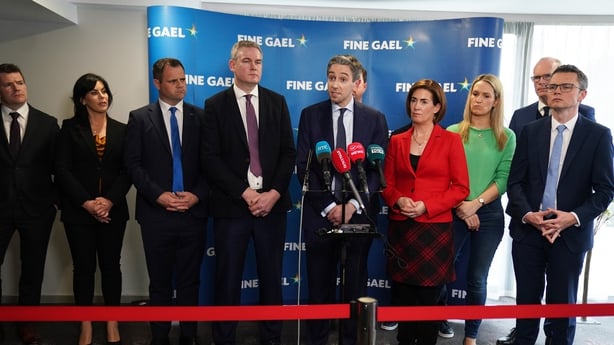
Whether it works or not remains to be seen, but for now party insiders are buoyant.
Fine Gael currently has 78 candidates for the general election, a figure that is likely to rise to the low 80s when the tickets are fully finalised and is expected to see it comfortably above the 40% female candidate gender quota requirement.
While a senior party strategist said they will not talk about expected seat numbers, stressing "we are not presuming anything", they did highlight a number of constituencies where the party hopes to make gains.
Those constituencies include Waterford, South Tipperary, Fingal West, Dún Laoghaire, Cork South West, Dublin North West and Laois.
The party is also hoping to retain most if not all of its existing seats, but that is more of a problem than strategists may want to admit, with more than half of Fine Gael's existing TDs not seeking re-election.
The defence put forward by one Fine Gael strategist, when asked about the issue, is that no candidate is inexperienced as they are already "well known in their areas" on key local issues and that they bring, here's that phrase again, a "new energy" to proceedings.
General Election 2024 maps and profiles: Your interactive guide to 43 constituencies
Behind the scenes, the party is confident that energy will help it to leapfrog both Fianna Fáil and Sinn Féin, which both won more seats in 2020, to become the biggest party in the Dáil after the general election.
More than one commentator has recently noted that Fine Gael leader Simon Harris does not currently have the look of someone who is aiming for another rotating taoiseach scenario, with one party backbencher recently suggesting it is time to "sweep the leg" and become the biggest party in any coalition.
Asked about the possibility though, the senior party strategist had a more cautious approach, saying Fine Gael's primary focus is simply to "go into the election and get as many seats as we can for our campaign", adding there is a difference between over-confidence and "determination, and I wouldn't confuse the two".
Fianna Fáil
That just-about-contained celebratory mood music will have raised an eyebrow in Fine Gael's current coalition partner Fianna Fáil, with one senior party strategist bristling at the notion Fianna Fáil might play second fiddle, and stressing the soldiers of destiny have designs on nothing less than winning the election themselves.
Micheál Martin's party is currently running 75 candidates with 41.3% female representation.
At least six more candidates are likely to be added over the coming days.
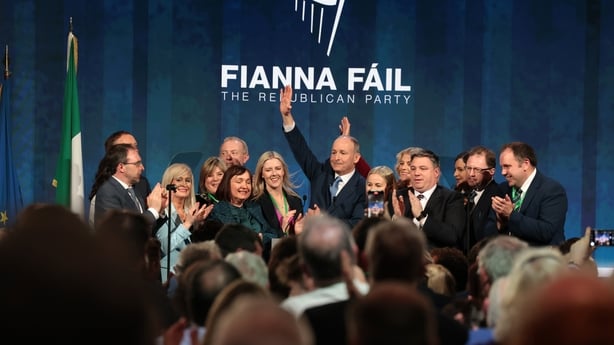
Asked about Fine Gael, one senior strategist was quick to point out that Fianna Fáil won more seats than its current partner in 2020, has more incumbent TDs than Fine Gael, was neck and neck with it in the local elections, and that, crucially for any election campaign, it remains "very strong on the ground, and this is a ground war".
The party is also reluctant to reveal how many seats it is targeting but said it is looking to "increase seats, and then after that we'll see what happens" - with Mayo, Louth, Wicklow-Wexford, Dublin South Central and Clare all mentioned.
A switch to a new coalition with Sinn Féin was firmly ruled out by two different party strategists, both of whom said it has been made "very clear" by Fianna Fáil TDs, senators, grassroots members and a certain party leader that it's seen as not feasible, with one strategist saying Sinn Féin has gone "even more to the left" on certain matters.
That of course in all probability leaves a version of the current coalition as a way back to power for Fianna Fáil, although what that version is remains to be seen.
Greens, Labour or gene-pool Fianna Fáil Independents, is how one party strategist outlined the options in terms of the smaller of the coalition partners -some or all of which may be needed to get the next government over the line.
And as for Fine Gael's confidence?
One Fianna Fáil senior strategist said firmly that if Simon Harris is looking at the same on-the-ground constituency-specific polling as Fianna Fáil, then a return of rotating taoisigh is what is on the cards.
A separate suggestion of a possible 2016-style confidence and supply arrangement was dismissed amid talk of Fine Gael dominance predictions being "PR on steroids".
Fianna Fáil, the strategist said, may be behind Fine Gael in current national polls. But he said newspaper polls were "wrong" about the party in the 2016 and 2020 general elections, and the 2019 and 2024 local elections, with Fianna Fáil saying its own polling suggests national polls will be wrong again.
Sinn Féin
Sinn Féin might be hoping the recent polls are wrong too.
For much of the current Dáil, the party had appeared to be by far and away the most popular in the country.
However, politics is fickle, and the sands of time wait for no man or woman, with more recent polls over the past year showing consistent downward trends into the percentage of teens.
The clutter of controversies for the party over the past month has hardly helped matters.
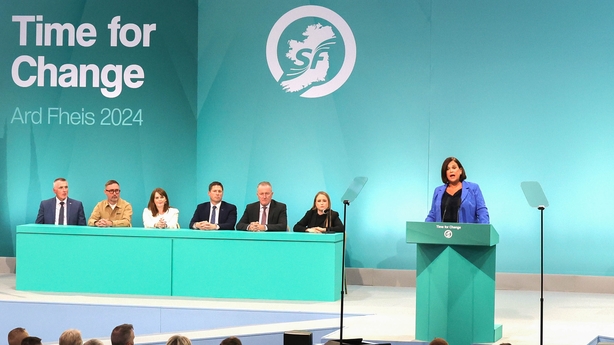
But, much like the Mark Twain phrase "the reports of my death are greatly exaggerated", the party believes it is not quite in as bad shape as some rivals would have voters believe.
Sinn Féin is currently running 60 candidates, with at least five more expected to be added including in Cavan-Monaghan on Sunday and Laois, where now Independent TD Brian Stanley is also running, on Monday. It is above the 40% female candidate gender quota.
One senior party strategist told RTÉ News that while the recent controversies to beset the party "are not a good look" they also "can't be helped" at this point.
He said that Sinn Féin's overall pitch to voters is to "give them a choice between more of Fine Gael and Fianna Fáil or something else", saying - perhaps not unexpectedly - that the party will focus heavily on housing, health and cost of living issues.
Back to the bread and butter, in other words.
And that bread and butter were objectively gobbled up by the electorate in 2020, when just five of Sinn Féin's 42 candidates were not elected, an impressive feat by anyone's calculations.
Sinn Féin strategists feel that a number of those unsuccessful candidates "hit the crossbar" last time.
With more than 20 additional candidates this time around, it will be hoping to have a good showing, regardless of the party's recent woes.
Asked if it would even consider a coalition with Fianna Fáil, the strategist stuck to the party line that this scenario is not on the agenda and that Sinn Féin wants the civil war parties out of government.
Talks may happen, but, at this stage, at least, Sinn Féin's focus remains on pitching itself to voters as a potential lead party in a coalition involving others to the centre left and left.
Green Party
While the Greens may in theory form part of that hypothetical mix, one senior Green Party strategist has for now watered down the option by instead saying the party would prefer to keep growing the existing coalition garden.
The Green Party is running a candidate in every constituency in the country, with its 53% female candidate percentage by far and away the biggest of any Dáil party.
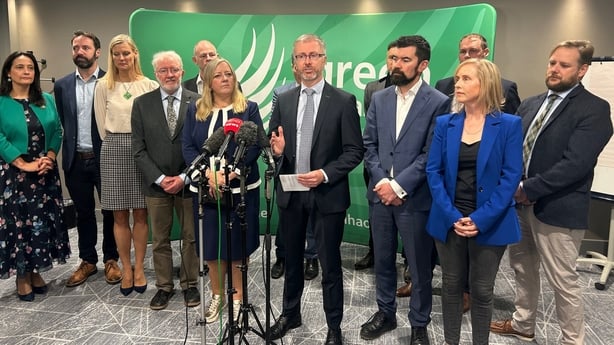
On a good day, a senior party strategist told RTÉ News the party wants to retain all of its existing seats, including Eamon Ryan's seat in Dublin Bay South, where councillor Hazel Chu is running, and to see its four senators based in the Republic elected to the Dáil. All are general election candidates.
The strategist also believes a number of other candidates have a chance, with Dublin Bay North, Louth and Cork South Central all earmarked as constituencies of interest, the latter of which is being targeted by a number of parties and is seen as something of a national bellwether this general election.
The Greens though are nothing if not realists, particularly with the memories of the 2011 wipeout still fresh in some members' minds, and are aware that four years in Government means it could be facing a bruising.
As such, solidifying their position and preventing seat losses is more the target than major gains.
The party's main intention in this election, therefore, is to ensure the current Coalition is re-elected.
One senior strategist said the idea of a coalition with Sinn Féin "would have to be discussed" but is far less likely.
Instead, the party believe the way forward is to remain as part of the Coalition so that environmental and climate policies continue to be progressed.
Asked if the Greens genuinely believe Fine Gael and Fianna Fáil feel quite as committed to the political relationship as their green-fingered friends, one senior strategist acknowledged there is talk of the larger Coalition partners looking towards Labour, the Social Democrats or Independents as potential alternatives.
"We're going to the electorate to say vote for us if you feel we've done a good job and held the other parties to account. It looks very likely Fine Gael and Fianna Fáil will get back in, so the only decision for voters is do you want the Greens to progress environmental issues, or Independents who won't," the strategist said.
Independent Ireland
Step forward, so, the Independents, and in particular the new kid on the Dáil political block, Independent Ireland.
The party, which is led by Cork South West TD Michael Collins, labels itself as practical, rural and traditional, although its detractors have also argued it has leaned to the right, some candidates far more than others.
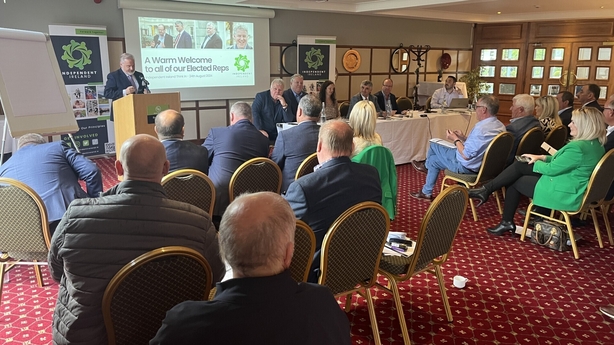
Independent Ireland was formed a year ago this week and has already had some electoral success, winning 24 seats in the local elections and seeing Ciaran Mullooly elected to the European Parliament, making it among the most high-profile of the growing number of Independent groupings both inside and outside of Leinster House.
Independent Ireland currently has three TDs, Deputy Collins, Richard O'Donoghue and Michael Fitzmaurice, and believes it can increase that number to between six and ten in the general election, a figure one member said means it would be a genuine option for Coalition talks.
At this stage, the party is running 18 candidates but expects that number to rise to the mid-20s in the coming days.
While it is likely to be above the 40% gender quota, one source said while it is nothing to worry about it is "neck and neck", and did not give an exact percentage figure at this stage.
"We were at 5% in the Red C poll last week, so on a good day we think we'll get ten seats, and that could probably make up the balance for a government," one party TD said.
"Most likely a coalition will need three parties, and the reason we founded Independent Ireland is to be in negotiations.
"If they adopt our policies we'd talk, but we won't be selling our soul for nothing either," he said, before adding: "It's not just one option though, we'd talk with anyone who takes our policies. And we'd be open to more Independent TDs joining us after the election."
Labour
Another party open to talks is Labour, which feels June's local and European election results mean it is far more solid than some have previously suggested, with a senior party strategist jokingly saying "we're certainly more optimistic this [general] election than the last couple".
The strategist believes the party, which is running at least 32 candidates and is above the 40% female candidate gender quota, will come back with between eight and 12 seats, a solid gain for a party that currently has six TDs after the departure of Aodhán Ó Ríordáin to Europe.
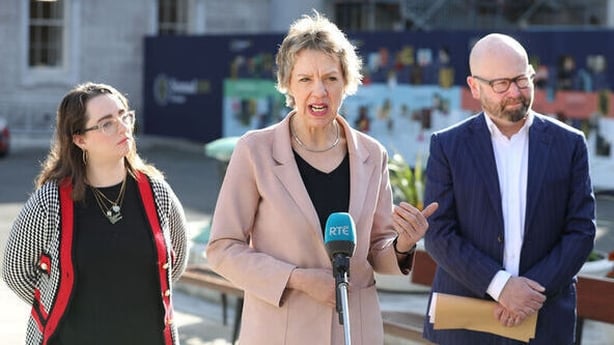
Among the potential gains being heavily targeted are Fingal West, Wexford where councillor George Lawlor will seek to retain the retiring Brendan Howlin's seat and Kildare South.
The party is also optimistic about Dublin South Central, Dublin South West and Dublin West, and believes on a good day it may be in contention in Cork North Central, Cork South Central, Limerick and Kildare North.
Whether any of that comes to pass is open to debate, but the party believes it can benefit from promoting itself as a more solid and practical left option than others, and importantly one which has been in government before.
The senior party strategist who spoke with RTÉ News said the party is keen on a broad left post-general election platform which would give parties of the centre-left and left a stronger hand to play in negotiations, a point recently made by party leader Ivana Bacik.
However, the strategist also acknowledged there has been little take up on this so far, meaning talks with the current big two coalition parties are also something Labour will consider.
"We've shown we have a steady hand in government," the strategist said. "This all comes down to the election result and any negotiations, but we want to have a say in the direction of this country, particularly as it is now a very volatile world."
Social Democrats
That post-election negotiations dance card is likely to be quite crowded if the Social Democrats are anything to go by.
"The main thing is we're interested in going into government. Some parties have put out this view that we're not, but we are. We're going to have some very clear red lines, but if our policy platforms are enacted then yes," a senior party strategist confirmed.
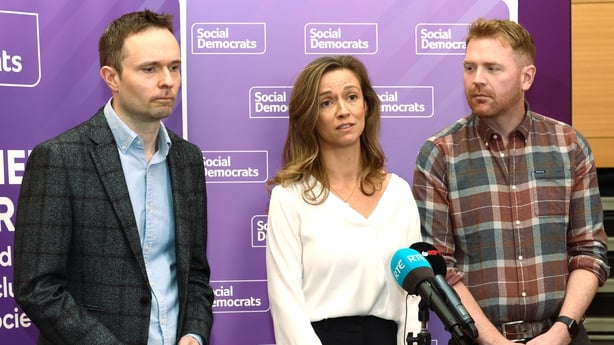
Now approaching their tenth year in existence, the Social Democrats have grown significantly over the past decade, and are now safely past the dangerous first few years for any new party, when finances and public interest can quickly wane.
Holly Cairns' party is running at least 24 candidates in the general election, 46% of whom are women.
It currently has six TDs, and believes this number can be increased to between ten and 12, with Cork East, Cork South Central and potentially Carlow-Kilkenny among the constituencies it is targeting.
The party is of course losing its two biggest figures in retiring TDs Catherine Murphy and Róisín Shortall in Kildare North and Dublin North West, but believes Rory Hearne and councillor Aiden Farrelly could retain those seats.
While in 2016, less than a year after the Social Democrats were formed, the party was cautious of being a coalition partner as it could become a potential mudguard and in 2020 its leaders continued to have some concerns, times change.
And, the party strategist who spoke with RTÉ News explained, the Social Democrats are nothing if not social political animals, meaning they will "talk with everybody" post-election.
Simon, Mícheál and Mary Lou, take note.
People Before Profit-Solidarity
One party unlikely to go into coalition with Fine Gael or Fianna Fáil, regardless of the election result, is People Before Profit-Solidarity.
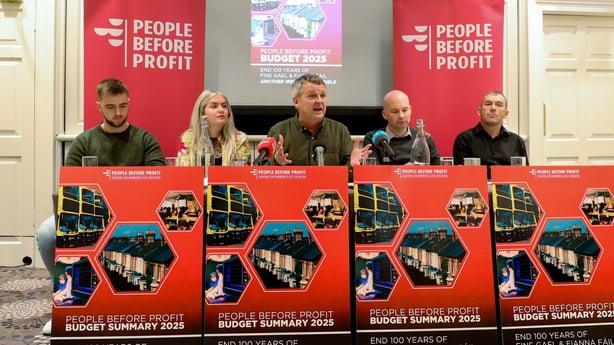
The grouping has always been clear that it is in the Dáil to make sure its version of the voice of the left and hard left is heard clearly, and now has a solid base of five TDs.
It is currently running 41 candidates in the general election, with at least two more due to be added in the coming days.
One party TD and key strategist is realistic that "on a good day we will be returning all of our TDs", including councillor Hazel de Nortúin who is running in Dublin South Central instead of the retiring Bríd Smith.
It believes Councillor Conor Reddy in Dublin North West may also be "a dark horse", but the party accepts that inevitably changing narratives during a campaign means making seat number predictions now is not an exact science.
One prediction the party's strategist is making is that Fine Gael, in particular, may have more difficulty than expected, due in part to its large number of new candidates who are, so far, untested on the national stage.
Another is that Sinn Féin may not do as poorly as some are suggesting - two predictions that could shake up the post-election talks.
Aontú
The final Dáil party making up part of the political jigsaw is Aontú.
Peadar Tóibín, currently the party's sole Dáil representative, and will be hopeful at least some of its 40 candidates, one in each constituency apart from Cork South West, Tipperary North and Wicklow-Wexford, could join him.
The party is understood to be aiming to win as many as seven seats in the next Dáil.
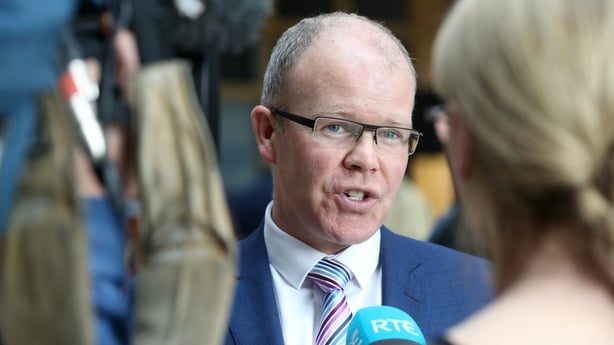
They include Meath West where Deputy Tóibín is based, Cavan-Monaghan, Dublin West, Wexford, Mayo, Limerick City and Cork North West.
If the general election campaign "crystalises around an opposition vote", Aontú believes it can ride that wave, although it accepts "not all [constituencies] are going to fall in our direction".
Party strategists say Aontú's second objective is more pragmatic, to win at least 4% of the national vote and therefore qualify for additional finances.
What is often overlooked is that election campaigns are not cheap, particularly for new parties and having missed out by 2,000 votes on State funding after the local elections, Aontú will be both ambitious and pragmatic in General Election 2024.
All to play for
The bottom line is that, with the general election now set to be called, party strategists and directors of election believe there is all to play for over the coming weeks.
Officially, the Coalition is firmly in favour of staying together for another term, while the opposition is equally firmly insistent that the current Government's time is up.
However, in reality? If it suits individual party interests - and if they, rather than their rivals, have the upper hand - then everything is on the table.
As the old saying goes, when it comes to games of poker you need to know "when to hold 'em and know when to fold 'em" - and as long as you have a chip and a chair, or even a seat in Dáil Éireann, you're still in the game.







